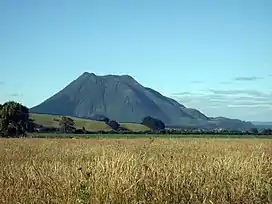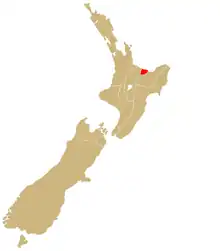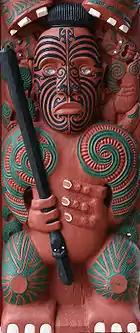Ngāti Awa
| Ngāti Awa | |
|---|---|
| Iwi (tribe) in Māoridom | |
 Pūtauaki, ancestral mountain of Ngāti Awa. | |
 | |
| Rohe (region) | Bay of Plenty Region |
| Waka (canoe) | Mātaatua |
| Population | 15,258[1] |
Ngāti Awa is a Māori iwi (tribe) centred in the eastern Bay of Plenty Region of New Zealand. It is made of 22 hapū (subtribes), with 15,258 people claiming affiliation to the iwi in 2006.[1] The Ngāti Awa people are primarily located in towns on the Rangitaiki Plain, including Whakatāne, Kawerau, Edgecumbe, Te Teko and Matatā.[2] Two urban hapū also exist in Auckland (Ngāti Awa-ki-Tamaki) and Wellington (Ngāti Awa-ki-Poneke).[3]
History

Early history
Ngāti Awa traces its origins to the arrival of Māori settlers on the Mātaatua waka (canoe). The Mātaatua settlers established settlements in the Bay of Plenty and Northland. Initially, the tribe controlled a large area in Northland, but conflicts with other northern iwi resulted in a southward migration. One group eventually settled in the eastern Bay of Plenty, whose descendants would eventually found the iwi.
Awanuiarangi II is recognised as the eponymous ancestor of Ngāti Awa. Awanuiarangi II was a chief descended from Toroa, captain of the Mātaatua. Descendants of Awanuiarangi II eventually formed their own iwi, Ngāti Awa, named after their ancestor.[2]
Tribal and land wars
Ngāti Awa was frequently at war with neighbouring iwi, including those with similar ancestry. Ngāti Awa initially had good trading relations with European settlers. However, the New Zealand Wars of the 1860s resulted in the British Crown confiscating more than 1,000 km² of Ngāti Awa land.
For more than a century afterwards, Ngāti Awa remained an aggrieved, struggling people. However, in 1999, the Waitangi Tribunal determined that the confiscation of Ngāti Awa land in the New Zealand Wars by the British Crown was illegal, and in 2003 a settlement was reached between Ngāti Awa and the New Zealand Government.
In the nineteenth century Ngāti Pūkeko were considered a separate iwi, but they are currently considered a hapū of Ngāti Awa.[2]
Government settlement
In 2003, following almost ten years of negotiations between the New Zealand Government and Ngāti Awa, a settlement was announced and reparations were made to the iwi. In summary:
- The New Zealand Government ('the Crown') acknowledged and apologised for the illegal confiscation of Ngāti Awa land during the New Zealand Wars
- The Crown paid NZ$42.39 million in reparations to Ngāti Awa
- The Crown agreed to return control of seven sites of historical and cultural significance to the iwi
- Three locations were renamed in accordance with original Ngāti Awa place names.[2]
On settlement the Ngāti Awa Research Centre that was established in 1989 to generate research for the Waitangi Tribunal claim became Ngāti Awa Research and Archives.[4][5]
Hapū and marae
Whakatāne hapū
The following hapū are based around Whakatāne and Coastlands:
- Ngāti Hokopū, based at Te Hokowhitu a Tū ki te Rāhui marae and Te Hokowhitu a Tūmatauenga wharenui, and at Te Whare o Toroa marae
- Ngāti Wharepaia, based at Te Hokowhitu a Tū ki te Rāhui marae and Te Hokowhitu a Tūmatauenga wharenui and Te Whare o Toroa marae
- Te Patuwai me Ngāti Maumoana, based at Toroa marae
- Warahoe, based at Tokitareke marae and Te Puna o Te Orohi wharenui
- Ngāi Te Rangihouhiri II, based at Te Rangihouhiri II marae
- Ngāi Taiwhakaea II, based at Taiwhakaea marae and Taiwhakaea II wharenui[3]
Poroporo hapū
The following hapū are based around Poroporo and Paroa:
- Ngāti Pūkeko, based at Pūkeko marae
- Ngāti Rangataua, based at Rangataua marae
- Ngāti Tamapare, based at Rewatu marae and Ueimua wharenui
- Te Whānau o Tariao Tapuke, based at Rangimarie marae and Rarawhati wharenui
- Ngāti Hikakino, based at Puawairua marae[3]
Te Teko hapū
The following hapū are based around Te Teko and Edgecumbe:
- Ngā Maihi, based at Tūteao marae
- Ngāi Tamaoki, based at Ruaihona marae
- Ngāi Tamawera, based at Uiraroa marae
- Ngāti Hāmua, based at Te Māpou marae and Rongotangiawa wharenui
- Te Pahipoto, based at Kokohinau (Tuhimata) marae and Oruatapare wharenui
- Tuariki, based at Tuariki marae
- Te Kahupāke, based in the area of Te Teko[3]
Matatā and Motiti hapū
The following hapū are based around Matatā and on Motiti Island:
- Te Tāwera, based at Iramoko marae and Te Paetata wharenui, in Matatā
- Te Patuwai me Ngāti Maumoana, based at Te Hinga o te Ra marae, and at Te Rua Kopiha marae and Tamatea ki te Huatahi wharenui, on Motiti Island[3]
Urban hapū
The following urban hapū are affiliated with Ngāti Awa:
- Ngāti Awa ki Poneke, based at Te Tumu Herenga Waka marae at Victoria University in Wellington
- Ngāti Awa ki Tāmaki Makaurau, based at Mātaatua marae and Awanuiarangi wharenui, at Māngere in Auckland[3]
Governance
Te Rūnanga o Ngāti Awa
Te Rūnanga o Ngāti Awa became the new governing body of the iwi in 2005.[2] Representatives from the Rūnanga were responsible for negotiating the settlement with the government on behalf of Ngāti Awa. Based in Whakatāne, the rūnanga manages the financial assets of the iwi, and promotes cultural, educational and economic development in the region.[6]
The trust manages the tribe's Treaty of Waitangi settlement under the Ngāti Awa Claims Settlement Act and is a body corporate for the tribe's land, under Te Runanga o Ngāti Awa Act. It represents the iwi in aquaculture and fisheries under the Māori Commercial Aquaculture Claims Settlement Act, and represents the iwi during resource consent consultation under the Resource Management Act. The trust is governed by one representative from each of the 22 hapū, and is based in Whakatāne.[3]
Local government
The tribal area of the iwi is within the territory of Kawerau District Council and Whakatāne District Council.
It is also within the wider territory of the Bay of Plenty Regional Council.[3]
Media
Sun FM
Sun FM is the radio station for Ngāti Awa. It was first known as Te Reo Irirangi o Te Manuka Tutāhi during a three-week AM trial run in 1990. It went to air as Tumeke FM in 6 April 1991, became Sun FM in 1994 to increase its advertising appeal, and between 1996 and 1999 worked to increase its Māori language content.[7] The classic hits station broadcasts on 106.5 FM in Whakatāne.[8]
Notable people
- Wepiha Apanui
- Leni Apisai
- Mere Broughton
- Catherine Carran
- Tāmati Coffey
- Samuel Horouta Emery
- Wira Gardiner
- Ngapiki Hakaraia
- Joe Harawira
- Matekoraha Te Peehi Jaram
- Georgina Kingi
- Karl Leonard
- Eruera Riini Manuera
- Hamiora Tumutara Te Tihi-o-te-whenua Pio
- Dan Pryor
- Kara Pryor
- Linda Tuhiwai Smith
- Albert Oliphant Stewart
- Te Hura Te Taiwhakaripi
- Maata Te Taiawatea Rangitukehu
- Eruera Hamiora Tumutara
- Gugi Waaka
- Te Kari Waaka
- Carin Wilson
See also
References
- "2006 Census – QuickStats About Māori (revised)". Statistics New Zealand. 4 April 2007. Archived from the original on 28 September 2007. Retrieved 25 May 2007.
- Harvey, Layne (26 September 2006). "Ngāti Awa". Te Ara – the Encyclopedia of New Zealand. Archived from the original on 1 May 2007. Retrieved 28 March 2007.
- "TKM Ngāti Awa". tkm.govt.nz. Te Puni Kōkiri, New Zealand Government. Retrieved 21 March 2018.
- Smith, Linda Tuhiwai (2012). Decolonizing methodologies : research and indigenous peoples (Second ed.). London. ISBN 978-1-84813-953-4. OCLC 861538625.
{{cite book}}: CS1 maint: location missing publisher (link) - "Ngāti Awa Research and Archives – Te Rūnanga o Ngāti Awa". Retrieved 7 May 2021.
- "Te Rūnanga o Ngāti Awa official website". Retrieved 21 March 2018.
- "Sun FM – Te Reo Irirangi o te Mānuka Tūtahi". Te Rūnanga o Ngāti Awa. Ngāti Aaw. Archived from the original on 25 February 2015. Retrieved 14 June 2015.
- "Iwi Radio Coverage" (PDF). maorimedia.co.nz. Māori Media Network. 2007. Retrieved 14 June 2015.